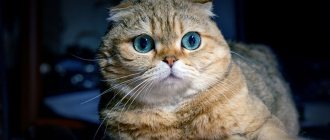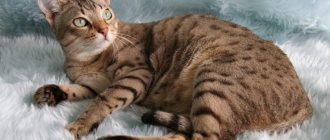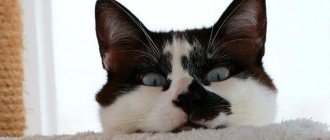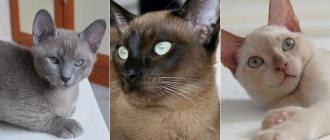Brazilian Shorthairs are domestic cats with a discreet appearance, an independent disposition and a soulful, bewitching gaze. Despite their ordinary exterior and resemblance to yard cats, they are not as simple as they seem.
To understand why Brazilian Shorthairs are so popular in their homeland, let’s look at the characteristics of this breed.
Brief history of the breed
These unremarkable cats simply lived on the streets of Brazil and did not attract the attention of local residents. And it is unknown how their future fate would have developed if professional felinologists had not become interested in them in the 80s of the last century.
Local experts began to select kittens with dominant characteristics of the breed and use them for breeding. As a result, by 1985 they developed the Brazilian Shorthair standard. At the same time, they submitted an application to register a new breed of cats, which remained unsatisfied.
Brazilian cats were combined with their European counterparts and classified as Celtic Shorthairs. But felinologists decided not to give up and continued to prove the uniqueness of the new breed. And in 1999, the WCF organization assigned the Brazilian Shorthair the status of an independent cat variety.
Coat and color of the Brazilian cat
A remarkable property of the Brazilian wool is the complete absence of undercoat. This is quite logical, since in the hot climate of Brazil there is no need for it. A fairly short “fur coat” fits tightly to the body. And although its structure is silky, according to the breed standard, wirehair is also acceptable. The reason for disqualification may be the non-adhesiveness of the coat or its plushness.
The colors of Brazilian cats can be listed endlessly, since the breed standard implies all possible colors. Moreover, a Brazilian will be just as beautiful in black as in red or gray. The only option when the appearance will be, as they say, not very good, is an acromelanic color.
Breed description, standards, appearance
Brazilian Shorthairs are graceful, slender cats with a slightly elongated, strong body and well-developed muscles. All characteristics of the breed are described in the official standard.
Dimensions and weight
The Brazilian cat is an elegant animal with average body parameters. Adult representatives of the breed weigh 3-5 kg. Moreover, cats look a little larger than cats.
Anatomical characteristics
A typical Brazilian cat should fit the following description:
- The head is elongated, of medium size, with a moderately long nose, smooth stop and a strong, slightly protruding chin.
- The ears are straight, regular triangular in shape, set wide apart. Can be decorated with neat tassels.
- The eyes are almond-shaped, slightly slanted, with an intelligent, penetrating gaze. The distance between the eyes is 1.5 times their width. The color of the iris can be any, but must be in harmony with the color of the coat. White Brazilian cats have blue eyes. In silvery individuals, the iris is green or yellow.
- The body is medium in size, rectangular in shape, with a rounded chest and developed muscles. The neck is muscular and strong.
- Limbs of equal length with small round paws.
- The tail is proportional to the body. Wide at the base, gradually tapering towards the tip.
Color and coat type
Brazilian cats have short, close-fitting, silky-to-the-touch fur with no undercoat at all.
The breed standard allows for the existence of any colors, with the exception of point variations.
Possible breed defects
Flaws in appearance that affect a decrease in expert assessment:
- presence of undercoat;
- small stature;
- minor deviations from the standard.
Defects for which the Brazilian Shorthair is subject to disqualification:
- disturbances in the structure of the body;
- lack of claws;
- cryptorchidism;
- deafness.
Origin story
The Brazilian Shorthair has come a long way from a street cat to a purebred cat. The Portuguese, who first arrived in Brazil in 1500, brought with them cats, whose task was to hunt rodents and thereby protect food supplies on ships. So working cats reproduced on their own, without any control, until in the 1980s Paulo Samuel Ruschi, an engineer by training but a cat lover, became interested in outdoor cats. He attempted to study the characteristics of the Brazilian cat and became the founder of the breed. Finally, in 1998, the WCF recognized the Brazilian Shorthair breed, and Paulo Samuel Ruschi himself founded a breed club in Rio de Janeiro. The number of breeders gradually grew, and breeding work continued. The breeding program used the European Shorthair. As a result, it was possible to obtain cats with different coat colors, independent and hardy.
Character and temperament
Brazilian cats have an affectionate and calm disposition. They treat all family members well, but do not like to be held. Freedom-loving, moderately talkative Brazilian cats rarely show importunity and calmly tolerate loneliness.
On a note. Although representatives of this breed have an independent character, they need their owner's love and care. Cats left unattended can become irritable and aggressive.
Brazilian Shorthairs get along well with children and willingly take part in outdoor games. But if a child does not know how to handle animals and offends them, then there is a risk that the pet will defend itself with its claws.
Cats of this breed do not conflict with their brothers and good-natured dogs, but do not tolerate rodents near them.
Where to buy a Brazilian Shorthair?
Unfortunately, in Russia and neighboring countries this breed is not very well known and popular. There are no nurseries offering kittens in this area. If you really want to buy a Brazilian Shorthair, you can scour the Internet looking for advertisements for sale, but there are very few of them, and the price there is higher than average.
We recommend visiting international cat shows, where some breeders offer babies from champion parents. For one kitten of this breed they ask on average from 300 to 500 dollars.
Brazilian Shorthair cats are wonderful creatures with an amazing history, wonderful character, expressive eyes, loving adventures and new acquaintances. It's impossible not to fall in love with them at first sight!
Popular kennels for this breed:
- Russia - (your nursery is here);
- Belarus - (take place);
- Ukraine - (submit an application).
How to choose the right kitten
Outside of Brazil, there are practically no nurseries that specialize in breeding this breed of cats. Therefore, buying a Brazilian Shorthair can turn into a kind of lottery.
In order not to run into scammers and not to shell out a tidy sum for an ordinary yard kitten, before purchasing an animal you need to make sure that it has documents confirming its origin and vaccinations.
When choosing a pet, you need to pay attention to the following characteristics:
- compliance with breed standards;
- physical activity;
- behavioral characteristics;
- skin and coat condition;
- cleanliness of ears and eyes;
- appetite.
Kitten care
Although Brazilian Shorthair kittens come from the cattery to their owners fully prepared for independent living, they require attention and care. At the initial stage, they are given a little time to adapt, and are also shown where they can eat, sleep and relieve themselves.
In order not to aggravate the stress of a change of environment, at first the little Brazilian is fed what the breeder advised. New foods are introduced into the kitten’s diet gradually. This will allow you to monitor whether they cause stomach upset or allergies. The Brazilian is fed small portions, but often. As you age, the number of meals you eat decreases.
To prevent the kitten from getting injured, wires, household chemicals and small objects are hidden from it in the new house. Also, indoor plants are removed from the little Brazilian, since many of them are poisonous to animals.
Price
Despite the popularity of cats in their homeland, the Brazilian Shorthair cat is not often found in Russia, so this fact is reflected in the cost. In addition, the breeder includes the costs of maintaining breeding animals and offspring into the total cost. In addition to food, the breeder spends money on veterinarian services, preparation of necessary documents for offspring, and animal care, which is reflected in the final price. A Brazilian Shorthair kitten costs over 75,000 rubles.
Similar articles:
- Ural rex
- Cornish Rex
- European shorthair cat
- Arabian Mau
- Burmese cat
- Chantilly Tiffany
Care and maintenance
The Brazilian Shorthair cat does not have an undercoat and does not tolerate dampness and low temperatures. For a comfortable life, she needs a warm and dry room with access to fresh air.
In order for a Brazilian to look neat, he is provided with appropriate hygienic care:
- The cat's eyes and ears are regularly wiped with a dampened cotton swab and inspected for unusual or excessive discharge.
- The claws of the Brazilian Shorthair are trimmed as necessary with a nail clipper so as not to touch living tissue and cause pain to the animal.
- Brush your cat's teeth weekly with a soft brush and a small amount of non-foaming toothpaste.
The coat of the Brazilian breed does not require special care. To maintain an aesthetic appearance, it is periodically combed with a medium-hard brush.
On a note. Brazilian cats do not like water, so in order not to expose the animals to unnecessary stress, they should only be bathed when absolutely necessary.
Catering
The Brazilian cat is not picky about food, so it will eat everything you offer. However, remember: you should never feed an animal from your table! Soups, many cereals, fried, salty, fatty, spicy foods will cause serious harm to health.
There are a number of rules:
- There should be two bowls: for water and for food. If you feed your animal natural food, the leftovers should be removed as soon as the cat eats, without allowing them to sour. Dry food can last longer.
- Clean water at a comfortable temperature (not cold or hot) should be freely available to the animal at all times. You cannot pour it from the tap! Use any household filter to clean it or leave it in an open container for 10-12 hours (during this time, harmful compounds will evaporate). You can also buy bottled water.
- Cats older than six months are fed 2 times a day: morning and evening. From 4 to 6 months - 3-4 times, babies - 5-6.
Natural products
Allowed to give:
- Lean meat (chicken, rabbit, veal, beef, lamb). The meat is pre-frozen in the freezer, and before feeding, the piece is doused with boiling water and cut into convenient (but not small) pieces.
- Offal (liver, hearts, stomachs, chicken necks) - they are stewed, boiled or served raw.
- Sea fish (hake, trout, salmon, flounder). The fish must be boiled and cleaned of bones. Do not feed your cat fish more than once a week: excess leads to kidney problems and the development of urolithiasis.
- Porridge (buckwheat, oatmeal, rice, millet). Porridge is fed every other day, adding a teaspoon of vegetable oil, chopped boiled chicken protein, vegetables (pumpkin, carrots, beets, zucchini, green beans, greens).
- Dairy products: cottage cheese, yogurt, sour cream, fermented baked milk, Varenets. Be careful with whole cow's milk: if the cat develops diarrhea, it should be removed from the diet.
It is prohibited to give:
- Fatty meat, bones, lard, skin;
- River fish;
- Sweet, smoked, salty, dried, canned;
- Sausage, frankfurters;
- Legumes, avocado, potatoes, onions, garlic;
- Juice, tea, coffee, mineral and sparkling water;
- Chicken yolk;
- Dog food;
- Human vitamins.
Recommended food
If you prefer ready-made food, keep in mind: you cannot take the first food you come across from the store shelf, and even more so, trust advertising slogans. Read the composition!
Good quality food contains ingredients, and high-quality products are used: fresh and dehydrated meat, fish fillets, natural preservatives (mixtures of tocopherols, for example), fruits and berries, rice, lentils, sweet potatoes, a complex of vitamins and minerals. Only from such food will your cat receive all the necessary substances, look good and feel great.
The holistic and super-premium food groups have proven themselves well. Holistic: Acana, Farmina N&D, Wellness CORE. Super-premium: Josera, Karmy, Landor.
Economy and premium food: Darling, Felix, Perfect Fit, Whiskas.
Below are the recommended holistic and super-premium foods. Links with the names of the food are clickable, on them you can, within our website, get acquainted with the descriptions of the food and read reviews from owners of Brazilian shorthair cats.
| Holistic | Holistic | Super premium |
| AATU | Gina Elite | Leonardo |
Consider the age and condition of your pet. Kittens need to be given more nutritious food, but castrated and sterilized animals change their hormonal levels, protein metabolism and the functioning of the genitourinary system, they begin to eat more - therefore, they need to buy completely different food.
Feeding the cat
In order for the Brazilian Shorthair to receive the entire range of vitamins and microelements along with its food, it is advisable to feed it with premium or super-premium drying. A cat of this breed is well suited for the following brands:
- Bosch;
- Royal Canin;
- Pro Plan;
- Pronature.
On a note. A dry-fed Brazilian cat should have easy access to clean drinking water.
With a natural type of feeding, the diet of a representative of the breed is designed so that it contains 70-80% meat. The Brazilian cat is also given fermented milk products, vegetables, cereals, ocean fish and eggs.
In order for the pet to remain healthy and active for a long time, sausages, smoked meats, onions, pork, potatoes, pastries, sweets and any food from the owner’s table are completely excluded from its menu.
If a Brazilian eats natural food, mineral supplements are additionally included in his diet. They are given twice a year, after preliminary consultation with a veterinarian.
Feeding
The Brazilian beauty will eat ready-made premium food with pleasure. Feeds of a lower class may also be to her taste, but they can be harmful to her health! Yes, the cost of the premium class is much higher, but the health of the family pet is also worth a lot.
Natural food for a Brazilian cat is meat and fermented milk products. Fish (both river and sea), as well as the liver of warm-blooded animals, can lead to infection with worms, and the consequences of this are long and difficult to treat, so we exclude fish.
Breeders note that you should also not feed your pet chicken skin, vegetables with a high starch content and red vegetables - the cat’s gastrointestinal tract cannot cope with them.
Video
Education and physical activity
Brazilian cats are energetic and active animals. Even in adulthood, they will not refuse to chase a ball or a laser pointer. To realize their hunting instincts, they will need several interactive toys. And so that cats of this breed can stretch their muscles, they have a sports corner.
Shorthaired Brazilians are endowed with outstanding mental abilities. Cats of this breed quickly adapt to different conditions and are easy to train. Brazilians not only easily learn basic rules of behavior, but also remember simple commands.
Diseases
Brazilian shorthair cats can live 15 or 20 years - much depends on the living conditions. Over many years of free life, cats of this breed have developed a strong immune system and do not have any characteristic genetic pathologies. But certain problems can arise even in such robust breeds as the Brazilian Shorthair.
- Firstly, these are parasites (most often worms). You can catch them both at home and on the street. Therefore, carry out the deworming procedure once a quarter.
- Secondly, it is wool in the stomach. No matter how diligently you brush your cat, when licking a certain amount of hair ends up in the stomach. Helping bring it out is quite simple: plant oat seeds at home. Eating seedlings causes the cat to vomit, which means that excess hair will come out. The second option is to give a special paste.
- Thirdly, these are diseases that only vaccination can protect a cat from. Calcivirosis, chlamydia, rabies, rhinotracheitis, infectious peritonitis, panleukopenia are very dangerous ailments that cause a lot of suffering to the cat and often end in the death of the animal. Modern multicomponent vaccines can completely protect the animal.
A peculiarity of Brazilian cats is the summer estrus (while in other breeds the “rut” occurs in the spring). At this time, the animal becomes irritable, noisy and restless. Cats can rush at doors and scream at night, but cats mark the apartment with an unpleasant and very pungent odor, which is difficult to get rid of. If your plans do not include raising and selling kittens, take the animal to a veterinary clinic, where it will be castrated or sterilized.
Expert opinion
Dusheba Vera Ivanovna
In 2010, she graduated from the Moscow State Academy of Veterinary Medicine named after K.I. Scriabin with honors, specializing in veterinary medicine. I regularly attend veterinary conferences, congresses, and webinars.
Females mature by one year. Gestation of kittens lasts a little less than 70 days. The Brazilian cat copes with both childbirth and newborns. Babies are born blind and deaf, begin to hear after 10-15 days, and see a little later. From one and a half months you can already start feeding them.
Health and susceptibility to disease
The Brazilian Shorthair is an indigenous breed that was formed in natural conditions without human intervention. Thanks to this, cats have good health and live about 15-20 years. They are not prone to serious hereditary pathologies and are little susceptible to infectious diseases.
On a note. Practice shows that in rare cases, Brazilians experience problems with the skin and digestive system. But all of them are caused by poor nutrition and can be treated.
Nutrition
“Brazilians” are not picky when it comes to food. Some exceptions should be made for the period when the animal is shedding, for example, a special paste is mixed into the food to prevent the formation of hairballs in the stomach. Water and food must be available to the animal at all times. Water should ideally be running.
Each animal should receive the amount of feed in accordance with its weight, age and activity. It is preferable to feed “premium” and “super premium” classes, as they have the best balance. A Brazilian kitten under the age of 1 year needs 30-60 g of food per day, and an adult animal needs 40-60 g.
Pros and cons of the breed
Brazilian cats, like representatives of any other breed, have not only advantages, but also disadvantages:
| pros | Minuses |
| Good health | Rarity of the breed |
| Good character | |
| Low maintenance |
Brazilian Shorthairs are animals that can easily be confused with their outbred relatives. But their developed intelligence, good health, excellent character and high adaptability make them almost ideal companions.
Character
Hardy Brazilian Shorthairs easily adapt to new living conditions. Animals are inquisitive, interested in what is happening around them, which can sometimes fascinate them. Representatives of the breed enjoy meeting new animals and people and are open to communication. Meowing pets are great with children and prefer to communicate with people rather than be alone. Therefore, they require a lot of attention from humans, giving affection and affection in return.
From time to time, cats show high energy, occupying themselves with games for a long time, especially being carried away by games that involve contact with humans. Animals are smart, so learning basic skills is quick, and pets can also be taught some simple tricks.
Cat food
This breed is not particularly demanding when it comes to food; it can easily get used to industrial food and then switch to natural food. Cats will happily eat a variety of raw vegetables and grass.
However, veterinarians do not recommend mixing both types of food. And if the choice is made towards natural food, it is better to get advice from a specialist. If the pet owner prefers natural food, you should select foods rich in vitamins and minerals.
As natural food, you can resort to such products as cottage cheese, lean meats (chicken, turkey), lean fish, cereals, soups. Among cereals, preference can be given to oatmeal, buckwheat and semolina.
You need to pay special attention to the choice of dry food. You should not use domestic food. The best varieties of dry food include elite brands from France and the USA (Roal Kanin K 34, Hills). They contain high-quality filler, various microelements and vitamins.
Contraindicated foods include the following foods: fatty fish and meat, various smoked foods, marinades, salt, tubular bones (poultry). In general, you should treat your pet with bones carefully: hollow bones can injure your pet’s esophagus and intestines when chewed. Cartilage is safer.
Frequent feeding on carrots and seafood can affect coat color. It has been noticed that if a cat frequently eats liver, the coat becomes darker.











